Flex、durability、fatigue培训
六西格玛黑带培训教材
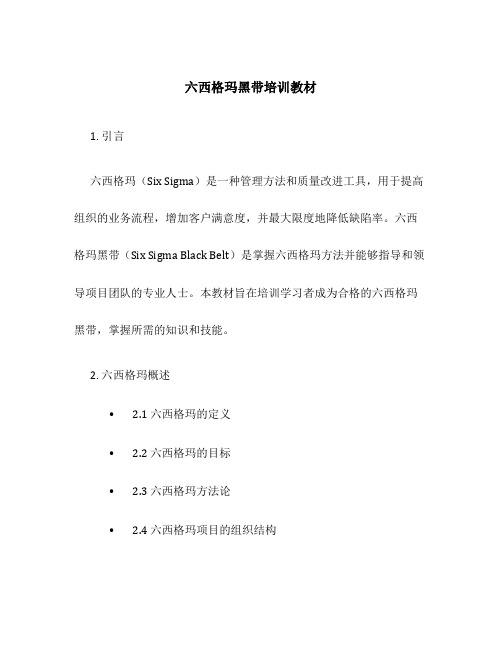
六西格玛黑带培训教材1. 引言六西格玛(Six Sigma)是一种管理方法和质量改进工具,用于提高组织的业务流程,增加客户满意度,并最大限度地降低缺陷率。
六西格玛黑带(Six Sigma Black Belt)是掌握六西格玛方法并能够指导和领导项目团队的专业人士。
本教材旨在培训学习者成为合格的六西格玛黑带,掌握所需的知识和技能。
2. 六西格玛概述• 2.1 六西格玛的定义• 2.2 六西格玛的目标• 2.3 六西格玛方法论• 2.4 六西格玛项目的组织结构3. 六西格玛工具3.1 流程映射流程映射是了解和分析业务流程的重要工具,通过绘制流程图,可以识别潜在问题和瓶颈,为改进提供基础。
3.2 变异性分析变异性分析是通过收集和分析数据,找出导致问题和缺陷的根本原因。
常用的变异性分析工具包括直方图、散点图、因果图等。
3.3 流程能力分析流程能力分析用于评估业务流程的稳定性和可控性,通过测量流程的高度和散布性,可以判断流程是否达到六西格玛的要求。
3.4 设计实验设计实验是用于验证和优化改进方案的方法,通过合理的设置实验条件和收集数据,可以较快地找到最优解。
3.5 样本调查样本调查是六西格玛黑带收集数据的重要手段,通过样本调查可以了解客户需求和满意度,为问题分析提供依据。
4. 六西格玛项目管理• 4.1 项目识别与选择• 4.2 项目团队构建与管理• 4.3 项目目标与指标设定• 4.4 项目计划与执行• 4.5 项目控制与监督• 4.6 项目总结与评估5. 六西格玛领导力• 5.1 六西格玛黑带的角色与职责• 5.2 六西格玛团队的领导与激励• 5.3 沟通与协作技巧• 5.4 冲突管理与解决• 5.5 变革管理6. 六西格玛实施案例分析本章将通过实施案例分析,让学习者了解六西格玛在实际项目中的应用,并通过分析成功案例和失败案例,总结经验教训。
7. 结束语六西格玛黑带培训教材通过系统的介绍和解释,为学习者提供了成为合格的六西格玛黑带所需的知识和技能。
福特竞速配件:高性能铝制杠杆臂指示书说明书

No cylinder head pedestal machining or additional components such as guide plates and rocker studs are required.
Engines with non-standard components, particularly performance camshafts, may need additional minimal machining or grinding of the pedestal inserts or different length push rods.
ALUMINUM ROLLER-TIP NEEDLE BEARING ROCKER ARMS STUD-MOUNTED TYPE AND BOLT-ON TYPE Instruction Sheet
NO PART OF THIS DOCUMENT MAY BE REPRODUCED WITHOUT PRIOR AGREEMENT AND WRITTEN PERMISSION OF FORD RACING PERFORMANCE PARTS.
TAPPET NOISE
Engines with standard components should run quietly without tappet noise. If engine operation was not noisy before installation of the rocker arms but is now, simple corrective action is necessary. See instructions below.
Factory Ford shop manuals are available from Helm Publications, 1-800-782-4356
BIQ制造质量员工培训教材

编制防错计划
二、制造工艺验证
24
二、制造工艺验证
防错的作用 把防错纳入产品设计中,来避免缺陷的产生;
把防错纳入过程设计中,从而在制造前发现缺陷, 防止缺陷的传递;
把防错纳入过程设计中,以便及时发现缺陷;
把缺陷从生产线中隔离出来,并采取遏制措施。
25
日常中的防错
二、制造工艺验证
客观的、理性的、可测量的、
主观的、情感的、直觉的、
绝对的
Measurable & Perceptual 相对的
Examples: 电器&功能性
• 午餐是根据订单配制的 • 车辆的转向很准确 • 前盖与翼子板的配合符合标准 • 收音机是工作的
Examples: 风格、外观、匹配、表面质量
• 食物看上去不错 • 路感相当清晰 • 前盖配合看上去不错 • 发动机声音很动听
防错
使变化点可视化– 当缺陷发生时进行识别; 防错对应质量三不原则中的“不接受缺陷”。
▪ 尽可能早的进行检查 ▪ 测量制造过程的输出 ▪ 注意变化点 ▪ 给遏制提供支持并作为不断改进的输入
41
三、工序控制和验证
有效的质量检查
42
三、工序控制和验证
有效的质量检查
① 在CARE检查的所有项目也必须在上游进行检查(生产部门最佳); ② 班组长和组员知道并理解必要的标准/产品质量标准,并将这个检查融入到
L3/L4 否/否 是/是 是/是 是/是 否/否 否/是
30
三、工序控制和验证
定义及目的
定义
通过对异常状况的预防、探测、遏制来稳定质量的系统。
目的
将过程产生的波动最小化,确保在本工位生产的产品质量OK,下 游问题能够得到及时的在线确认以减少缺陷而带来的不必要浪费。
鞋测试要求
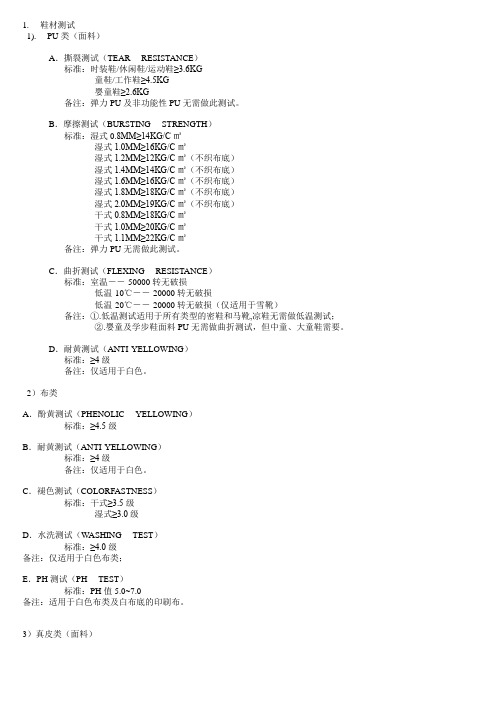
1. 鞋材测试1). PU类(面料)A.撕裂测试(TEAR RESISTANCE)标准:时装鞋/休闲鞋/运动鞋≥3.6KG童鞋/工作鞋≥4.5KG婴童鞋≥2.6KG备注:弹力PU及非功能性PU无需做此测试。
B.摩擦测试(BURSTING STRENGTH)标准:湿式0.8MM≥14KG/C㎡湿式1.0MM≥16KG/C㎡湿式1.2MM≥12KG/C㎡(不织布底)湿式1.4MM≥14KG/C㎡(不织布底)湿式1.6MM≥16KG/C㎡(不织布底)湿式1.8MM≥18KG/C㎡(不织布底)湿式2.0MM≥19KG/C㎡(不织布底)干式0.8MM≥18KG/C㎡干式1.0MM≥20KG/C㎡干式1.1MM≥22KG/C㎡备注:弹力PU无需做此测试。
C.曲折测试(FLEXING RESISTANCE)标准:室温---50000转无破损低温-10℃---20000转无破损低温-20℃---20000转无破损(仅适用于雪靴)备注:①.低温测试适用于所有类型的密鞋和马靴,凉鞋无需做低温测试;②.婴童及学步鞋面料PU无需做曲折测试,但中童、大童鞋需要。
D.耐黄测试(ANTI-YELLOWING)标准:≥4级备注:仅适用于白色。
2)布类A.酚黄测试(PHENOLIC YELLOWING)标准:≥4.5级B.耐黄测试(ANTI-YELLOWING)标准:≥4级备注:仅适用于白色。
C.褪色测试(COLORFASTNESS)标准:干式≥3.5级湿式≥3.0级D.水洗测试(W ASHING TEST)标准:≥4.0级备注:仅适用于白色布类;E.PH测试(PH TEST)标准:PH值5.0~7.0备注:适用于白色布类及白布底的印刷布。
3)真皮类(面料)A.撕裂测试(TEAR RESISTANCE)标准:①.牛皮/牛反毛:婴童鞋/拖鞋≥7.0KG时装鞋/休闲鞋/童鞋/运动鞋/舞鞋≥10KG工作鞋≥15KG②.柔软皮/服装皮:婴童鞋/拖鞋≥5.0KG时装鞋/舞鞋≥7.0KG休闲鞋/运动鞋≥10KG③.山羊皮/猪皮:0.6MM-0.8MM:≥3.0KG0.8MM-1.0MM:≥4.0KG1.0MM-1.2MM:≥5.0KG1.2MM-1.4MM:≥6.0KGB.曲折测试(FLEXING RESISTANCE)标准:室温---50000转无破损备注:①.PU榔皮标准为50000转无轻微破损;②.婴童及学步鞋的真皮鞋面无需做此项测试;C.褪色测试(COLORFASTNESS)标准:干式≥3.5级湿式≥3.0级备注:油感皮、擦拭皮、需打处理剂的皮、牛巴戈用做鞋面时标准为干式≥2.5级,湿式不做要求;D.耐汗测试(PERSPIRATION)标准:≥3.0级F.耐黄测试(ANTI-YELLOWING)标准:≥4级备注:仅适用于白色PU榔皮;G.水洗测试(W ASHING TEST)标准:≥4.0级4)PVC(内里、中皮)A.耐磨测试(ABRASION RESISTANCE)标准:高级≥25600转中级≥12800转低级≥6400转B.耐黄测试(ANTI-YELLOWING)标准:≥4级备注:适用于白色和浅色;C.褪色测试(COLORFASTNESS)标准:干式≥3.5级湿式≥3.0级5)后套里(不织布、猪榔皮等)A.耐磨测试(ABRASION RESISTANCE)标准:高级≥51200转中级≥25600转低级≥12800转B.褪色测试(COLORFASTNESS)标准:干式≥3.5级湿式≥3.0级C.耐汗测试(PERSPIRATION)标准:≥3.0级6)松紧带A.抗拉强度测试(TENSILE STRENGTH)标准:童鞋≥15KG/CM成人鞋/男童鞋≥20KG/C MB.反复拉伸性能测试(RESISTANCE TO REPEATED EXTENSION)标准:10000转时表面无破损、橡皮筋破损<10%。
FaureciaQBTRAINING佛吉亚QB培训教材

Qualification process :
The trainee has understood all the 7QB tools and the mindset behind them.
Program : Introduction: BQP and Relation to 7QB OK 1st Part Poka Yoke Self-Inspection Final Inspection / TQW Red Bins Rework under control QRCI
Timeframe
1.5 hours
Trainer(s) level 4 – who can conduct
3
Breakthrough Quality Plan
7 QB of BQP + 7 QB in Production + 7 QB in Development
The BQP is a top-down approach setting 7 practical and simple rules designed to address our main weaknesses in production and in development
Reaction rules for NOK status
OK product checksheet
Checkpoint
What to check?
How to check?
OK / NOK?
What to do if NOK?
Validated by GL
OK 1st Part – Mandatory Rules
Standardize
Establish “good housekeeping" rules. Formalize storage and cleaning procedures.
联合立华内部培训材料英文版

02
The company is committed to promoting diversity and inclusion among its employees, empowering a culture of respect and equality
Customer service skills: Training materials for customer service positions should cover effective communication techniques, active listening, handling issues, and problem-solving skills
要点一
要点二
Training content
including company culture, product knowledge, sales skills, team collaboration, and other aspects, using a combination of online and offline methods for training.
Familiarizing employees with common acronyms and admissions used within the company and industry
Safety training materials
Introduce the company's safety production rules and regulations, including operating procedures, safety technical standards, etc., to ensure that employees understand and comply with relevant regulations.
生产管理新人IDL训练教材-
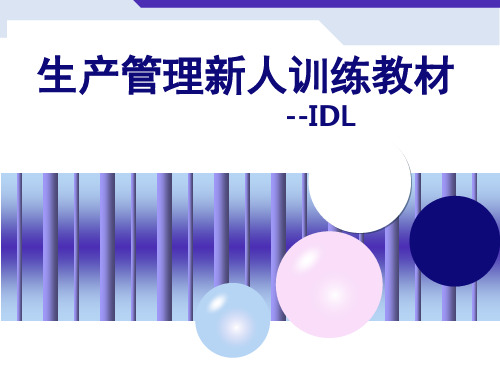
HB
YOUR SITE HERE HBTechnology Inc.
非无尘物品管制 无 尘 室 禁
止
物
品
LOGO
非无尘物品包括:非无尘纸、铅笔、水笔、 钢笔、橡皮擦、立可白、香烟、药品及任何 食物及饮料 未经清洗过的设备仪器及工具并申请合格的 摄影、照相器材 任何会造成产生 Particle 的物品
LOGO
反射片的功能是將被散射的光源再反射進入 光傳導區內,並防止漏光. 常用的有SKC的RP-10 , Toray的E60L , Kimoto的RW-188以及 Tsujiden的RF-188
2016/8/26
YOUR SITE HERE
偏光片介绍
偏光片的用途 偏光片结构介绍 离型膜与保护膜的区分方式 偏光片上片与下片之区分 偏光片吸收轴之认识及方向辨认 点的定义 翘曲度定义及规格
YOUR SITE HERE
(五)、偏光片吸收轴之认识(1)
LOGO
WV型和SWV型偏光片吸收轴是很重要的,因为它们上面有液晶层 .在观查其吸收轴时,需注意以下事项: 对偏光片吸收轴进行观察时,保护膜面需朝上(即有印记一面 朝上)。 上偏光片和下偏光片的吸收轴方向是相同的。 吸收轴的方向与偏光片之拉伸方向相同,在反射灯光下观察它 的拉伸斜纹以确定吸收轴方向。 吸收轴方向所反应的也是WV的TAC膜和SWV的TAC膜上液晶 的方向,正确做好标记是很重要的。
LOGO
YOUR SITE HERE
1 . 導光板(Light Guide)
導光板是背光模組(BLU)光源的傳遞 媒介 ,主要功能是將光源導引至整個可視 面. 其形狀及材料組成將決定光出射 面的輝度及分布上均一性的表現.
LOGO
量体裁衣别具一格的杜邦培训

目录 CONTENTS
• 培训理念 • 培训内容与方法 • 培训实施与效果评估 • 培训师资力量 • 培训设施与资源 • 企业文化与培训融合
01
培训理念
个性化培训理念
尊重个体差异
提升自我管理能力
杜邦培训认为每个员工都是独特的, 具有不同的学习风格、兴趣和潜力。 因此,培训应尊重个体差异,提供个 性化的学习和发展机会。
杜邦鼓励员工自我管理学习进程,培 养自主学习的能力,使他们能够更好 地应对工作中的挑战和变化。
激发潜能
通过个性化的培训,杜邦致力于激发 员工的潜能,帮助他们发现并发展自 己的优势,从而在工作中发挥更大的 价值。
员工发展为本
01
02
03
关注员工成长
杜邦以员工发展为核心, 关注员工的个人成长和职 业发展,通过培训提供持 续学习和发展的机会。
工作中。
工作场所模拟
通过模拟真实的工作环境,杜邦培 训为员工提供实践机会,帮助他们 更好地适应工作环境和解决实际问 题。
跨部门合作与交流
杜邦鼓励员工参与跨部门培训和交 流活动,以促进团队合作和知识共 享,提高整体工作效能。
02
培训内容与方法
定制化课程设计
针对不同岗位和职能
杜邦培训的课程设计充分考虑了不同岗位和职能的需求,确保课 程内容与实际工作紧密相关。
中级员工培训
针对有一定工作经验的员 工,提供专业知识和技能 提升的培训,促进个人职 业发展。
高级员工培训
针对高层管理人员,提供 战略思维、领导力等方面 的培训,提升企业整体管 理水平。
培训效果跟踪与反馈
培训后评估
通过问卷调查、面谈等方式,收 集员工对培训的反馈意见,评估
ADAMS 初级培训

17
Constrain model
Idealized joints Joint primitives Motions generators Contact
18
Applying forces
Build | Forces 1. Apply forces 2. Flexible connectors 3. Special forces 4. Contact forces
Length (x), Height (y), Depth(z), Anchor CSM, Parent Part Length (z), Radius, Anchor CSM, Parent Part 3-Diameters, Anchor CSM, Parent Part Length(z), Bottom and Top Radii, Anchor CSM, Parent Part Radius of Ring (xy plane), Radius of Circular Crosssection (⊥ to xy plane), Anchor CSM, Parent Part
23
Example 1 kinematical simulation
24
Build part
7 8
6 4 3 2 1 5
25
constrains
26
Simulation
27
Measure output
28
postprocessor
29
Design for air spring
F·∆s+G·∆h+T ·∆x=0 F---hand force G---gravity T---air spring force
Formel-Q第八版培训资料
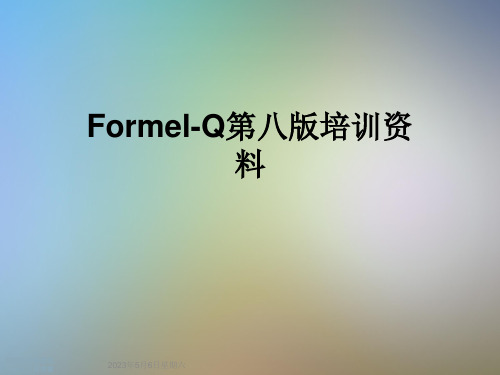
是否只和获得批准/放行且具备质量能力的供方开展合作?
针对采购的产品和服务,是否获得了必要的批准/放行?
针对采购的产品和服务,约定的质量是否得到保障?
是否对来料进行了适当的仓储,所使用的运输工具/包装设备是否适合来料 的特殊特性? 在生产控制计划的基础上,是否在生产和检验文件中完整地给出了所有重要 的信息?
Formel-Q是大众汽车集团与 其供应商建立共同合作的基 本准则,由以下几个模块组 成 质量管理协议(总协议) 供应商质量能力评价准则 新零件的质量开发计划 QPN(包括两日生产验收)
路漫漫其修远兮, 吾将上下而求索
第3页
Formel-Q质量能力简介
Formel-Q质量能力
以VDA专业组制定的汽车工业质量标 准为依据 按照ISO/TS16949和VDA6.1建立的 质量管理体系的基本要求 大众集团对外购件(包括产品、过 程、检验技术上)的特殊要求
第10页
紧急措施
潜在供应商评价(POT)
➢ 潜在供应商审核依照VDA6.3的具体程序来实施,选用P2~P7部分共35个提问,针对潜在
供应商分析的每一个提问,采用信号灯评价系统进行评价
➢ 分析总评价也采用信号灯系统(各个提问评价结果相加)
评级
评价结果
黄灯
红灯
被告禁止的供应商
●
>14
≥1
带条件放行的供应商
Fragen
评价
是否建立了项目组织机构(项目管理),并且为项目管理以及团队成员确定 了各自的任务和权限?
是否已经编制了一份项目计划,并且与顾客进行了协商沟通?
针对产品和过程的具体要求是否已明确?
在产品和过程要求已明确的基础上,是否对制造可行性进行跨部门分析?
Flex、durability、fatigue培训
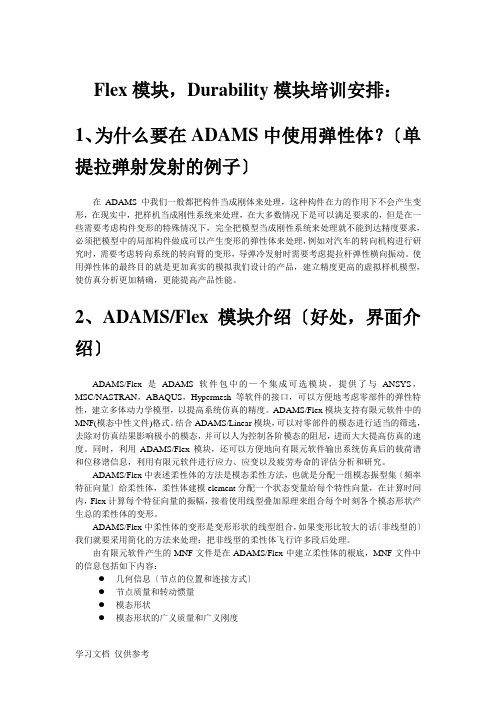
Flex模块,Durability模块培训安排:1、为什么要在ADAMS中使用弹性体?〔单提拉弹射发射的例子〕在ADAMS中我们一般都把构件当成刚体来处理,这种构件在力的作用下不会产生变形,在现实中,把样机当成刚性系统来处理,在大多数情况下是可以满足要求的,但是在一些需要考虑构件变形的特殊情况下,完全把模型当成刚性系统来处理就不能到达精度要求,必须把模型中的局部构件做成可以产生变形的弹性体来处理,例如对汽车的转向机构进行研究时,需要考虑转向系统的转向臂的变形,导弹冷发射时需要考虑提拉杆弹性横向振动。
使用弹性体的最终目的就是更加真实的模拟我们设计的产品,建立精度更高的虚拟样机模型,使仿真分析更加精确,更能提高产品性能。
2、ADAMS/Flex模块介绍〔好处,界面介绍〕ADAMS/Flex是ADAMS软件包中的—个集成可选模块,提供了与ANSYS,MSC/NASTRAN,ABAQUS,Hypermesh等软件的接口,可以方便地考虑零部件的弹性特性,建立多体动力学模型,以提高系统仿真的精度。
ADAMS/Flex模块支持有限元软件中的MNF(模态中性文件)格式。
结合ADAMS/Linear模块,可以对零部件的模态进行适当的筛选,去除对仿真结果影响极小的模态,并可以人为控制各阶模态的阻尼,进而大大提高仿真的速度。
同时,利用ADAMS/Flex模块,还可以方便地向有限元软件输出系统仿真后的载荷谱和位移谱信息,利用有限元软件进行应力、应变以及疲劳寿命的评估分析和研究。
ADAMS/Flex中表述柔性体的方法是模态柔性方法,也就是分配一组模态振型集〔频率特征向量〕给柔性体,柔性体建模element分配一个状态变量给每个特性向量,在计算时间内,Flex计算每个特征向量的振幅,接着使用线型叠加原理来组合每个时刻各个模态形状产生总的柔性体的变形。
ADAMS/Flex中柔性体的变形是变形形状的线型组合,如果变形比较大的话〔非线型的〕我们就要采用简化的方法来处理:把非线型的柔性体飞行许多段后处理。
《Flexi培训教程》PPT参考课件
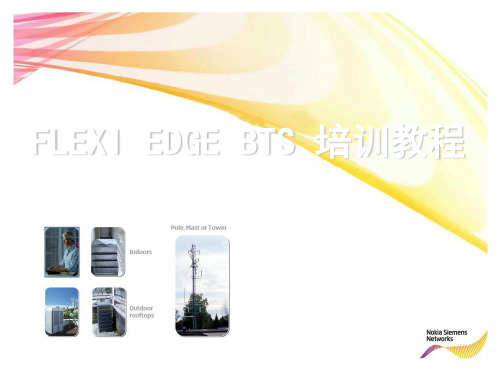
设备连接方法
1 TRX
2 TRX连接方式
TX 连接方式
RX 连接方 式
8 TX合路
8 RX合路
2 TRX TX RX连接
ESMA/ESEA 8+8+8
CDT RX1
C DT RX2
INSTALLATION GUIDE EDGE/BTS 8+8+8 WBC 4:1
Modules
1
2 3
ESMA结构及主要功能
系统单元ESMA
包括以下部分: •核心模块 •电源模块FPMA •传输接口
ESMA主要功能:
•ABIS终结,操作管理。 •传输接口。 •系统时间。 •系统接口(DTRX以太网接口和交换)。 •扩展接口(告警输入、输出、控制接口)。 •测试支持(测试支持和控制接口)。 •供电。 •基站支持柜告警搜集。 •Q1接口。
空间要求 FlexiBTS 可安装在墙上或支柱上,也可置于机柜中. •机房要有充足的操作及维修空间 • 机房应远离振动源和强噪声源,避开强电磁场的干扰 •站点易于接进,且能安全工作 •要能提供合适的电源线及传输线的走线路由及走线架 •推荐机柜上端及前部应有便于维护的自由空间, •安装空间必须具备良好的通风条件 •对无机柜防护的安装方式,建议设备置于低灰尘环境
21
22
WBC 12
23
DTRX 8
24
ESEA
25
26
27
WBC 13
DTRX
9
28
29
WBC 14
WBC 15 DTRX 10
30
31
32
WBC 16
DDU 3 WBC 17 DTRX 11
33 34 WBC 18 DTRX 12 35
护理诊断及措施128个护理诊断医学培训PPT

23.体液过多(Fluid Volume Excess 24.体液不足(Fluid Volume Deficit
33.有窒息的危险(Risk for Suffocation) 37.组织完整性受损(ImPaired Tissue Integrity) 41.调节颅内压能力下降( Decreased AdaPtive CaPacityIntracranial)
2.营养失调:低于机体需要量(Altered Nutrition:less Than Body Requirements)
7.体温过高(Hypothermia)
11.感知性便秘(Perceived Consttipation) 15.排尿异常(Altered Urinary Elimination) 19.功能性尿失禁(Functional Incontlnence)
4.有感染的危险(Risk for Infection )
68.社区应对无效(Ineffective Community Coping)
70.不合作(特定的)(Noncompliance)(Specitfy)
65.家庭应对无效:妥协性 (Ineffectiv Family Coping: Compromised)
67.社区应对:潜能性(Potential for Enhanced Community CoPing)
72.遵守治疗方案无效(社区的)(Ineffective Management 73.遵守治疗方案有效(个人的)(Effective
流动能力培训液体气管筒腿布设计路径指南说明书
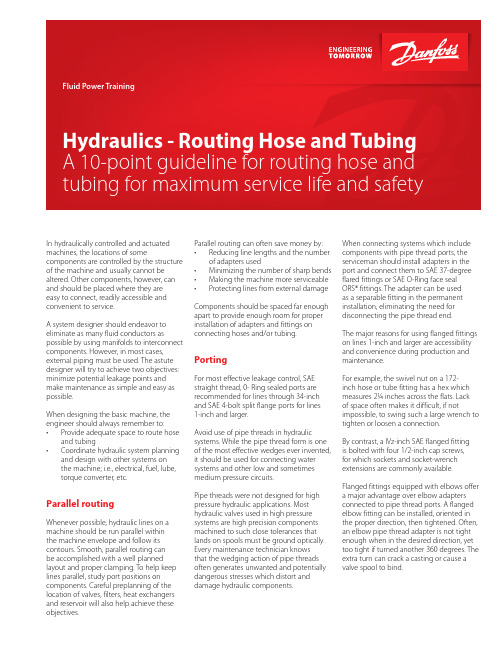
In hydraulically controlled and actuated machines, the locations of some components are controlled by the structure of the machine and usually cannot be altered. Other components, however, can and should be placed where they are easy to connect, readily accessible and convenient to service.A system designer should endeavor to eliminate as many fluid conductors as possible by using manifolds to interconnect components. However, in most cases, external piping must be used. The astute designer will try to achieve two objectives: minimize potential leakage points and make maintenance as simple and easy as possible.When designing the basic machine, the engineer should always remember to:• Provide adequate space to route hose and tubing• Coordinate hydraulic system planning and design with other systems onthe machine; i.e., electrical, fuel, lube,torque converter, etc.Parallel routingWhenever possible, hydraulic lines on a machine should be run parallel withinthe machine envelope and follow its contours. Smooth, parallel routing canbe accomplished with a well planned layout and proper clamping. To help keep lines parallel, study port positions on components. Careful preplanning of the location of valves, filters, heat exchangers and reservoir will also help achieve these objectives.Parallel routing can often save money by:• Reducing line lengths and the numberof adapters used• Minimizing the number of sharp bends• Making the machine more serviceable• Protecting lines from external damageComponents should be spaced far enoughapart to provide enough room for properinstallation of adapters and fittings onconnecting hoses and/or tubing.PortingFor most effective leakage control, SAEstraight thread, 0- Ring sealed ports arerecommended for lines through 34-inchand SAE 4-bolt split flange ports for lines1-inch and larger.Avoid use of pipe threads in hydraulicsystems. While the pipe thread form is oneof the most effective wedges ever invented,it should be used for connecting watersystems and other low and sometimesmedium pressure circuits.Pipe threads were not designed for highpressure hydraulic applications. Mosthydraulic valves used in high pressuresystems are high precision componentsmachined to such close tolerances thatlands on spools must be ground optically.Every maintenance technician knowsthat the wedging action of pipe threadsoften generates unwanted and potentiallydangerous stresses which distort anddamage hydraulic components.When connecting systems which includecomponents with pipe thread ports, theserviceman should install adapters in theport and connect them to SAE 37-degreeflared fittings or SAE O-Ring face sealORS® fittings. The adapter can be usedas a separable fitting in the permanentinstallation, eliminating the need fordisconnecting the pipe thread end.The major reasons for using flanged fittingson lines 1-inch and larger are accessibilityand convenience during production andmaintenance.For example, the swivel nut on a 172-inch hose or tube fitting has a hex whichmeasures 2¼ inches across the flats. Lackof space often makes it difficult, if notimpossible, to swing such a large wrench totighten or loosen a connection.By contrast, a IVz-inch SAE flanged fittingis bolted with four 1/2-inch cap screws,for which sockets and socket-wrenchextensions are commonly available.Flanged fittings equipped with elbows offera major advantage over elbow adaptersconnected to pipe thread ports. A flangedelbow fitting can be installed, oriented inthe proper direction, then tightened. Often,an elbow pipe thread adapter is not tightenough when in the desired direction, yettoo tight if turned another 360 degrees. Theextra turn can crack a casting or cause avalve spool to bind.Hydraulics - Routing Hose and Tubing Danfoss Fluid Power Training2 | © Routing Hose and Tubing Danfoss Fluid Power Training | 2023.02.AN443357173491en-000101It is good practice to turn elbow pipe thread adapters in 90-degree increments and adjust the piping to fit. If otherpositions are used to position an adapter, communicating this information to production and maintenance people may not only be difficult, but downright dangerous. We have seen installations where piping was forced to mate with an adapter which was positioned incorrectly. The results were unfortunate: kinked tubing, hose bent at radii much smaller than recommended and ultimate failure.Hose and tubingThe system designer must first determine whether hose and/or tubing is best for a particular application. Designers should think of hose and tubing not as separate entities, but as companion items; each offers specific benefits. For example, tubing can:• Be bent to smaller radii than hose andinstalled in tighter spaces• Be routed through areas of higherambient heat• Handle hotter fluids than can hose • Provide superior heat transfercharacteristics On the other hand, tubing can be flattened or damaged when struck, whereas hose is resilient and more apt to absorb a blow and return to its original shape. Tubing may fatigue when connected to high frequency vibrating components; hose will absorb the vibration.Where lines are long, tubing may require a series of intricate, close tolerance bends which may complicate installation and ultimately create service problems. The flexing properties of hose, on the other hand, allow it to follow desired contours and make hose installation easier. Hose can absorb some high transient pressureshocks, providing more uniform flow patterns as well as smooth and quieter operation. Where hydraulic rigidity is required, hose is not recommended because of its tendency to act as an accumulator.GOOD DESIGNS FOSTER GOOD MAINTENANCEHere are 10 rules of thumbfor correctly routing and properly installing fluid conveying components. This guideline should be most useful during machine prototyping. After all “bugs” have been removed, normal production procedures should be followed.1. Start with large linesBecause they are the hardest to bend and maneuver, especially in tight spaces, install the largest ID lines first and the toughest part of the job is done.Smaller lines provide more routingversatility and can be more easily “worked” in tight spaces. Each line should be routed to conserve maximum space. This not only results in a neater looking installation, but makes future modifications or additions of accessories easier, more convenient and more economical.2. Correct hose length The appearance and efficient operation of a system oftendepends on using proper length hoses. Excessive hose footage increases pressure drops and system cost. Hose assemblies are commonly manufactured to specified lengths as well as increments of lengths. This practice helps minimize the size of inventory which must be carried. When computing hose length, remember that hose can shorten up to about 4% when pressurized.3. Hose flexingAlways remember that a hose assembly is designed to flex or bend, not twist. It has been shown that if a large diameter, high pressure hose is twisted 7 degrees, its service life can be reduced by as much as 90%!High pressure hose must be routed to flex in only one plane. If plumbing requires that hose be routed through a compound bend, the hose should be “broken” into two or more sections so each will flex through only one plane. Although a spring guard will keep hose from bending beyond the minimum bend radius at the fitting, it will not prevent the hose from twisting.4. Pivot pointsWhen hose must flex, be sure to route it through the pivot point around which the component is moving, Figure 1. This will result in the best and most efficient flexing of the hose line, use the least amount of hose and keep the hose within the contour of the machine.Fig. 1. In flexing applications, the hose assembly should be routed through the pivot point around which the componentis moving.Hydraulics - Routing Hose and Tubing Danfoss Fluid Power TrainingAN443357173491en-000101© Routing Hose and Tubing Danfoss Fluid Power Training | 2023.02. | 3To achieve this, the hose should bepositioned to bend like a hinge. Otherwise, the hose may have a tendency to take an S-bend which is most likely to happen when the hose is pushed rather than bent. An S-bend installation results in excessive hose movement and reduced service life.When piping a flexible line through a pivot point, consider the relative positioning of the two end fittings to avoid an S-bend. Follow this procedure:• Swing the moving component to its farthest point where the hose will experience its widest bend.•If the fittings are placed in parallel planes at this point, the hose will tend to flex in a hingelike manner when the component is swung back to the opposite end of its travel.5. Reciprocating motionIn addition to flexing, the ends of the hose may have to reciprocate. There are several design methods:• Hose reels - For use with high pressurehydraulic hose, these reels areequipped with high pressure swivel joints and a spring return to help rewind the hose.• Festooning - Hose is hung in loopsfrom a steel cable, Figure 2. As one point of the loop moves away from the other, the loops open to form almost a straight line.• Rolling - Hose is arranged in anunbalanced U-shape, one leg being stationary and longer than the second, which is free to reciprocate parallel to the first. Hinged tracks carry the hose.6. Rotary motionSwivel or rotary joints are commonly used to provide rotating motion. Where rotarymovement is a continuous 360 degrees, use a rotary joint; if, however, movement is reversing, a swivel joint would be the better choice.When used with hose, a swivel joint will avoid hose twisting or bending at the fitting, Figure 3.7. Controlling oil sprayWhere hydraulic lines must be routed near hot, potentially hazardous areas, protection against fire must be used to prevent oiI from a broken line from spraying onto any potential source of ignition. Here are some ways to accomplish this:• Route the line through a tunnel madefrom steel tubing, channel or angle iron.• Install a sheet metal baffle between thelines and potential ignition source.• Route the lines through a large, open-ended hose or sleeve so the oil will flow out of the ends in case of line failure.• Use fire sleeves that either fit over thehose or are built into the hose cover.• To guard against a failed hose thatmight whip and spray hydraulic oil over an ignition source, anchor the hose to the component to which it is hydraulically connected.Fig 2. Festooning consists of attaching hose to a steel cable in hanging loops. As one point moves away from the other, the loops open to straighten the hose as needed.Fig. 3. Swivel joints used on the ends of hose assemblies will eliminate twisting and bending at the fittings. The photo at left shows an installation with fixed fittingsand at right is the same application with swivel joints. Notice the neatness provided by a Cordura. (Cordura is a DuPont trademark.)4 | © Routing Hose and Tubing Danfoss Fluid Power Training | 2023.02.AN443357173491en-000101Danfoss can accept no responsibility for possible errors in catalogs, brochures, and other printed material. Danfoss reserves the right to alter its products without notice. This also applies to products already on order provided that such alterations can be made without subsequent changes being necessary in specifications already agreed. All trademarks in this material are the property of the respective companies.Danfoss and the Danfoss logotype are trademarks of Danfoss A/S. All rights reserved.About Danfoss Power Solutions FCTo learn more please visit: /en/about-danfoss/our-businesses/ power-solutions Danfoss Power Solutions 14615 Lone Oak Road Eden Prairie, MN 55344, USAPhone: 952-937-9800•8. Minimum bend radiiSAE specifications and fitting manufacturers’ catalogs list the minimum bend radii for various size hose. The figures usually refer to the minimum bend radius at maximum operating pressure for a static line. When a line is flexed, the minimum radius increases in relation to the number of degrees through which the hose line flexes. The designer should plan to increase the minimum bend radius when the hose is flexing, by applying an N factor to the normal, recommended bend radius.For example, the minimum bend radius for -12 high pressure hose is 9½ inches (measured from the inside bend of the hose) at 3000 psi. If the hose line flexes through 140 degrees, the N factor is 1.4. Multiplying 9.5 by 1.4 gives a new bend radius of 13.3 inches for this -12 hose at a pressure of 3000 psi.9. Avoid abrasionMost hydraulic hose is built with a tough outer cover to protect the hose reinforcement from abrasion and/ormoisture damage. Constant abrasion at one point will eventually puncture the outer cover and weaken the reinforcement. For this reason, route and clamp the hose so it will not abrade, Figure 4, or use a protective cover.Choose from a variety of protective coverings:• Coiled springs • Coiled strap steel • Spiraled plastic • Nylon sleeves10. ClampingA piping installation is not complete until it has been properly clamped. Clamp choice is very important; often it can be critical, Figure 5. Common sheet metal clamps will not hold a large, high pressure hose.Good clamps can be inexpensive, yet highly effective for high pressure surge lines. Anticipate and plan for a possible length change ranging from +2 to -4% for high pressure lines. Proper routing and clamping should be planned to avoid areas of vibration. Never clamp hose on a bend.Good routing avoids crossed lines. Where unavoidable, clamp the two crossing lines together at the junction point. However, NEVER clamp together high and low pressure hoses which run parallel. The differential in respective length changes is likely to result in a seesaw action which will damage the hoses.Properly sized clamps should grip hose in a positive manner. To keep the clamp from abrading the hose, the ID of the clamp should be about 1/32-inch smaller than the OD of the hose.Hydraulics - Routing Hose and Tubing Danfoss Fluid Power TrainingFig. 4. The tough outer cover of a hose assembly will abrade if exposed to continuous rubbing in the same spot. To avoid this problem, route and damp to keep hose dear from interfering objects.Fig. 5. The choice of sheathing and damping bundles of hose assemblies must be studiedcarefully. Hose should be routed to provide properdamping, yet allow for flexing when pressurized.。
康采恩生产体系培训材料V3.2
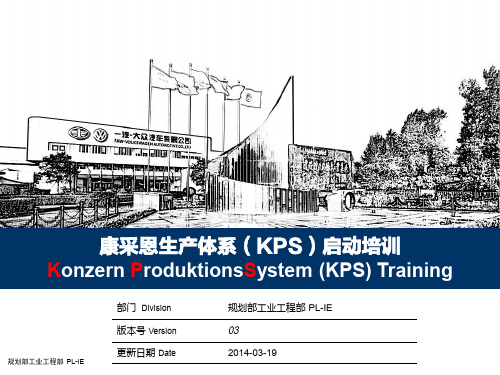
……
第7阶段
Konzept Produkt Prozess Anlauf
规划部工业工程部 PL-IE
3. 推行康采恩生产体系(KPS)的方式
康采恩生产体系的培训方式——逐级培训
培训内容 培训者
公司体 系发展 KPS KPS 方法 概况 审核 模块 史
X X
高级经理
T.BOM
IE 教练员
X
X
X
二级经理和管理人员 KVP-Kaskade主持人
不符合人 机工程
运输
不必要的过程
规划部工业工程部 PL-IE
无效的沟通
缺陷/返修
1. 发现9种浪费
1) 生产过剩
生产过剩是指,对比客户的需求,提前 生产了或过量生产了客户没有需求的产品。
现象 举例:
1.提前生产 2.仓库过满 3.产品落灰或长期放置导致失效 2) 库存 由于生产过剩、大批量生产、岛国意识 或为避免风险而造成了库存,掩盖了其它多 种问题。
KPS第41个方法模块 ——现场管理
生产系统 PS
节拍原则 Takt 流动原则 Fluss 拉动原则 Pull 完美原则 Perfektion
人机分离
料箱方案 无料箱备货
基础 Grundlage
工作标准化
规划部工业工程部 PL-IE
“基础”方法模块(12个)
1. 发现9种浪费
生产过剩
库存
等待
行走/动作
现象 举例:
1.物料摆放占用物流通道 2.查找零件耗时耗力
规划部工业工程部 PL-IE
1. 发现9种浪费
3) 等待
由于生产过程或环境的影响,导致员工不 能操作或设备停止,造成等待的浪费。
现象 举例:
延锋国际培训资料
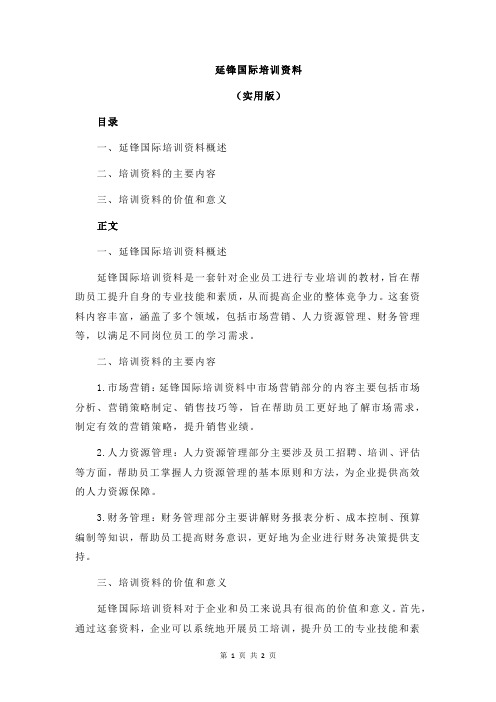
延锋国际培训资料
(实用版)
目录
一、延锋国际培训资料概述
二、培训资料的主要内容
三、培训资料的价值和意义
正文
一、延锋国际培训资料概述
延锋国际培训资料是一套针对企业员工进行专业培训的教材,旨在帮助员工提升自身的专业技能和素质,从而提高企业的整体竞争力。
这套资料内容丰富,涵盖了多个领域,包括市场营销、人力资源管理、财务管理等,以满足不同岗位员工的学习需求。
二、培训资料的主要内容
1.市场营销:延锋国际培训资料中市场营销部分的内容主要包括市场分析、营销策略制定、销售技巧等,旨在帮助员工更好地了解市场需求,制定有效的营销策略,提升销售业绩。
2.人力资源管理:人力资源管理部分主要涉及员工招聘、培训、评估等方面,帮助员工掌握人力资源管理的基本原则和方法,为企业提供高效
的人力资源保障。
3.财务管理:财务管理部分主要讲解财务报表分析、成本控制、预算编制等知识,帮助员工提高财务意识,更好地为企业进行财务决策提供支持。
三、培训资料的价值和意义
延锋国际培训资料对于企业和员工来说具有很高的价值和意义。
首先,通过这套资料,企业可以系统地开展员工培训,提升员工的专业技能和素
质,为企业的长远发展储备人才。
其次,员工通过学习这套资料,可以提升自己的综合能力,为个人的职业发展打下坚实基础。
最后,延锋国际培训资料可以帮助企业和员工适应不断变化的市场环境,增强企业的竞争力。
载荷分解
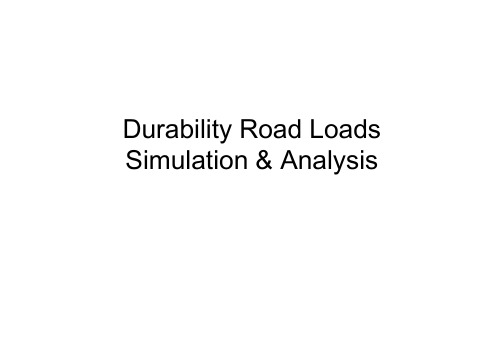
Multibody Suspension Model (rigid links)
Durability Analysis
Hard points
Unit Load Cases
Geometry
Body and Chassis FE System Model
Linear FEA
Nonlinear FEA
Loads Histories at Key Interfaces
NASTRAN ABAQUS
ABAQUS DYNA NASTRAN
Stress per Unit Load
Yes
Severe Loading?
Resultant Stress Time Histories
No
Strength/Integrity Estimation
Fatigue/Damage Calculations
11
Basic Components in Multi-Body Dynamics Models
• Parts • Joints • Bushings • Forces • Motion • Springs • Marker • Beam
SLA with Torsional Bar Front Suspension
22
Rear Suspension Model
4 Link Panhard Rear Suspension
Hotchkiss Rear Suspension
23
Full Vehicle Twist Model
24
Challenges
M A SLR
- 1、下载文档前请自行甄别文档内容的完整性,平台不提供额外的编辑、内容补充、找答案等附加服务。
- 2、"仅部分预览"的文档,不可在线预览部分如存在完整性等问题,可反馈申请退款(可完整预览的文档不适用该条件!)。
- 3、如文档侵犯您的权益,请联系客服反馈,我们会尽快为您处理(人工客服工作时间:9:00-18:30)。
Flex模块,Durability模块培训安排:
1、为什么要在ADAMS中使用弹性体?(单提拉弹射发射的例子)
在ADAMS中我们一般都把构件当成刚体来处理,这种构件在力的作用下不会产生变形,在现实中,把样机当成刚性系统来处理,在大多数情况下是可以满足要求的,但是在一些需要考虑构件变形的特殊情况下,完全把模型当成刚性系统来处理就不能达到精度要求,必须把模型中的部分构件做成可以产生变形的弹性体来处理,例如对汽车的转向机构进行研究时,需要考虑转向系统的转向臂的变形,导弹冷发射时需要考虑提拉杆弹性横向振动。
使用弹性体的最终目的就是更加真实的模拟我们设计的产品,建立精度更高的虚拟样机模型,使仿真分析更加精确,更能提高产品性能。
2、ADAMS/Flex模块介绍(好处,界面介绍)
ADAMS/Flex是ADAMS软件包中的—个集成可选模块,提供了与ANSYS,MSC/NASTRAN,ABAQUS,Hypermesh等软件的接口,可以方便地考虑零部件的弹性特性,建立多体动力学模型,以提高系统仿真的精度。
ADAMS/Flex模块支持有限元软件中的MNF(模态中性文件)格式。
结合ADAMS/Linear模块,可以对零部件的模态进行适当的筛选,去除对仿真结果影响极小的模态,并可以人为控制各阶模态的阻尼,进而大大提高仿真的速度。
同时,利用ADAMS/Flex模块,还可以方便地向有限元软件输出系统仿真后的载荷谱和位移谱信息,利用有限元软件进行应力、应变以及疲劳寿命的评估分析和研究。
ADAMS/Flex中表述柔性体的方法是模态柔性方法,也就是分配一组模态振型集(频率特征向量)给柔性体,柔性体建模element分配一个状态变量给每个特性向量,在计算时间内,Flex计算每个特征向量的振幅,接着使用线型叠加原理来组合每个时刻各个模态形状产生总的柔性体的变形。
ADAMS/Flex中柔性体的变形是变形形状的线型组合,如果变形比较大的话(非线型的)我们就要采用简化的方法来处理:把非线型的柔性体飞行许多段后处理。
由有限元软件产生的MNF文件是在ADAMS/Flex中建立柔性体的基础,MNF文件中的信息包括如下内容:
●几何信息(节点的位置和连接方式)
●节点质量和转动惯量
●模态形状
●模态形状的广义质量和广义刚度
查看mnf文件的相关信息,单位,模态,模态矢量等等(用得较多)
把mnf文件转换成ASCII文件,供ADAMS/Solver使用。
把nastran的out文件转换成mnf文件。
对mnf文件进行自动优化。
3、模态综合法介绍
自20世纪60年代以来,国内外对于大型复杂结构系统的动力分析方法进行了大量研究,其目标主要在于通过缩减大型复杂结构的动力模型的自由度,来达到兼顾分析精度及计算效率的目的. 模态综合技术方法就是在这种背景下提出的一种特别有效的减缩自由度的方法.
线弹性结构(绝大多数金属零件在承受工作载荷时均属于线弹结构)在自由或强迫振动下,其在任意时刻的振动形状是所有模态的线性组合,即:
模态综合法有多种理论及计算方法,MSC Adams采用的是Craig-Bampton方法,它是基于运
动学的观点来构造结构的Ritz基.
首先将结构划分为若干子结构,子结构内部的任一点位移,可以写出如下形式:
式中,x B是边界自由度,x I是内部自由度,ΦC是约束模态,ΦN是保留的低阶主模态,p B和p C 是对应于主模态的广义坐标,Φ为对应于广义坐标的变换矩阵. 柔性体的运动方程可以写
成如下形式:
M ,K 和f 分别为广义质量阵、广义刚度阵和模态坐标系下的载荷矢量,而F为物理坐标系下的载荷矢量.
4、patran中建立弹性体的详细流程和设置,nastran进行弹性体模态分析,得到模态中性文件。
Patran_Nastran_Adams_Fatigue_简体中文.ppt
练习上述流程
5、ADAMS中的刚柔耦合系统级仿真(导出mdf文件,dac文件)
Mdf文件可用于模态应力恢复,dac文件用于疲劳分析
练习上述流程
6、集成化疲劳寿命分析
(复习使用patran、nastran、adams进行刚柔耦合分析流程,进而介绍使用dac文件,在patran 中调用fatigue进行集成化疲劳寿命分析的流程。
)
图2虚拟疲劳耐久性集成化仿真分析流程
MSC公司为用户提供了一套如图2所示的虚拟疲劳耐久性集成化仿真分析流程,该分析流程的基础理论是模态综合法。
第一步:在Patran中建立研究部件的有限元模型,并进行相关的设置,以便提交给Nastran 计算时能生成mnf模态中性文件;
第二步:把Patran生成的bdf文件提交给Nastran计算生成mnf模态中性文件以便供ADAMS使用,同时需要生成op2模态结果文件;
第三步:在ADAMS中建立系统的多刚体动力学模型,通过ADAMS/Flex接口使用mnf 中性文件替换所要研究的部件,建立刚柔耦合多体动力学模型进行仿真计算,使用ADAMS/Durability接口中的MSC.Fatigue选项导出应力形状时间历程文件(Stress Shapes Time Histories,dac文件);
第四步:在Patran/Fatigue中导入op2和dac文件后,定义工况,材料信息进行疲劳计算生成fef文件;
第五步:在Patran的后处理中查看部件的疲劳寿命等所关心的信息,必要时返回第一步重新建立仿真模型来优化部件的疲劳寿命及其分布。
为什么要进行动态疲劳分析?
随着行业竞争加剧,通过加快产品研发速度、降低产品成本、提高产品可靠性的手段提高产品竞争力,已经为各企业所认可. 疲劳分析是一个重要途径,在产品研发中得到越来越多的应用. 汽车零部件疲劳分析方法主要有静态(或准静态)、动态、随机振动疲劳分析等,对于给定的问题,应根据结构所受载荷及其动态特性不同,判断并选择正确的疲劳分析方法. 静态(准静态)疲劳分析方法的应力时间历程采用线性静态叠加法计算,并应用Miner准则进行疲劳分析,计算效率很高,因而在汽车零部件的疲劳分析上得到广泛应用. 但由于静态(或准静态)疲劳分析方法忽略动态因素,当结构的固有频率与外载荷的频率接近时,计算结果存在很大误差.
疲劳寿命的基本知识讲解和集成化疲劳寿命分析的流程
Fatigue可以进行结构的初始裂纹分析、裂纹扩展分析、应力寿命分析、焊接寿命分析、整
体寿命预估分析、疲劳优化设计、振动疲劳分析、多轴疲劳分析、点焊疲劳分析、虚拟应变片测量及其数据采集等各种分析。
全寿命分析,又叫名义应力法(S-N)
在MSC.Fatigue中分析高周疲劳的方法叫全寿命分析法,又叫名义应力法(S-N),是最早形成的抗疲劳设计方法,以材料或零件的S-N曲线为基础,对照试件或结构疲劳危险不为的应力集中系数和名义应力,结合疲劳累积损伤理论,校核疲劳强度或计算疲劳寿命。
外加应力水平和标准试样疲劳寿命之间的关系的曲线称为材料的S-N曲线。
S-N曲线使用试验的方法获得,通常获得一条S-N曲线至少需要15个构件,在双对数坐标下画S-N曲线时,交变应力S和失效循环次数N的关系是一条直线。
疲劳累积损伤理论介绍
在机械结构上,疲劳损伤通常被解释为受损伤结构的使用寿命减少了。
当结构受高于疲劳极限的应力时,每一循环都使结构产生一定量的损伤,并且这种损伤是累积的。
当损伤累积到临界值时,结构就会发生破坏。
按照疲劳累积损伤规律,目前所提出的疲劳累积损伤理论分为三类:线性疲劳累积损伤理论、修正的线性损伤理论和非线性疲劳累积损伤理论。
这三类疲劳损伤理论都有各自的优缺点,线性疲劳累积损伤适合于高周疲劳寿命估算,它能较好地预测疲劳寿命的均值;修正的线性疲劳累积损伤理论主要用于低周疲劳寿命估算;非线性疲劳累积损伤理论则对二级加载情况的疲劳寿命估算比较有效。
导弹吊挂疲劳属于高周疲劳,因此本文选用线性累积损伤理论对进行寿命估算。
实力讲解:吊挂疲劳寿命分析
沙滩车悬架摆臂的集成化疲劳寿命分析(adams_patran_nastran_fatigue联合仿真.doc)
练习上述流程。
